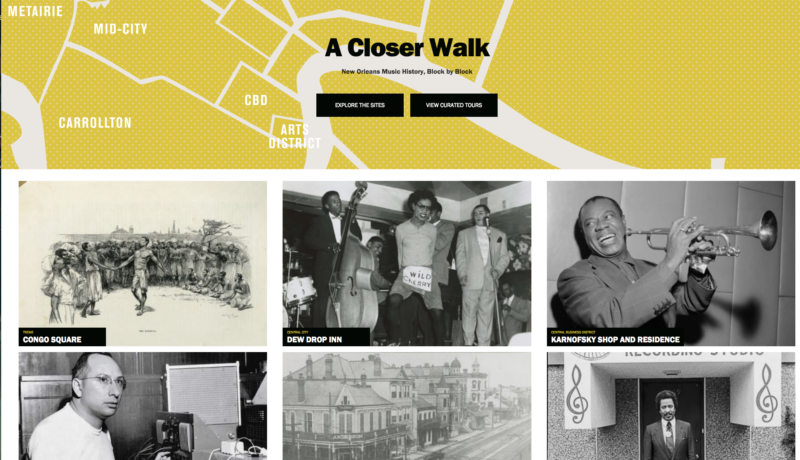
A Closer Walk charts a musical-history course through New Orleans (Photo: acloserwalknola.org)
New Orleans has a great new tool for music lovers. A Closer Walk is an interactive, location-based website about New Orleans music history. Just tap the map and you can find rare photos, stories by local music writers, songs, oral histories with local artists, and even links to buy New Orleans records and books. Recently we talked about A Closer Walk with one of the project’s founders, local author Randy Fertel.
Give us the 30-second elevator pitch about A Closer Walk. What is it and how did it come about?

Author and philanthropist Randy Fertel is one of A Closer Walk’s chief architects. (Photo: fertel.com)
A Closer Walk is a mobile-optimized site, which means that it lives on the Internet, not on your phone. But you go to the Internet to go to our URL, which is acloserwalknola.com, and then you save it to your home screen. So, on your desktop, you can use it as an armchair traveler visitor to New Orleans jazz or New Orleans music sites. As a tourist or a New Orleanian who wants to learn more about our music history, you can explore it using your phone or your iPad. The beauty of it is that there’s all this archival material, all this audio visual material.
It started way back in the ‘90s, believe it or not, before there were apps, when Ron Ridenhour and I decided we were going to do a jazz history walking tour book. Then he suddenly died and I put that on the shelf. But then, about 10 years later, when apps were beginning, I thought, that’s what it needs to be. It needs to be an app. Then I finally found Kevin McCaffrey to manage the production of this, and then after Charles Chamberlain helped us write all the jazz material, and then I went to WWOZ figuring, well, if they put their name on it and it is the WWOZ Closer Walk, then that would get more eyeballs on it. But they insisted that it be free, so I would have to walk away from my investment. I did. This is a free site. Just as we were prepared to make it into an app, we learned that Bent Media was already working on this mobile-optimize idea with Ponderosa Stomp. So, we joined together at Bent Media. Ira Padnos, Doctor Ike, who founded Ponderosa Stomp, has decades worth of panels and all this material that now you can access through our site. So, instead of just being a jazz walking tour, it’s a walking tour of New Orleans music history. What I love about it is because it’s map based, it’s location based, things reveal themselves that had never revealed themselves to me. For example, I’ve long given what I call the Fertel Funky Tour, which is basically New Orleans beyond Bourbon Street. Congo Square is an essential part of that tour. The birthplace of jazz. The place where the call and response element of jazz, the syncopation, the habanera rhythm that Jelly Roll Morton said was essential if it was to be jazz. All that was in that bamboola, all those drum rhythms that they were allowed to play on Sundays at Congo Square. Well, another part of my Fertel Funky Tour was the J and M Studios across the street, but I never really connected the two in an essential way, which is that J and M studios is where rock and roll was born. You know? There are arguments for other places, just as there are for jazz, but in an essential way, rhythm and blues and rock and roll, which was nursed by Dave Bartholomew, who was a jazz musician, and all his side men, all his studio musicians for that birth of rock and roll were jazz musicians. So, what dawned on me as I explored our map and read the text under J and M Studio on our site was, oh my God, what is this incredible synchronicity that these two things that touched world culture in a way that hardly anything else has were born two blocks from one another? It’s just incredible
One thing about this tour is it’s pretty comprehensive. It’s not just about jazz. What time periods and genres does it cover?
Well, it starts in the 1890s and before the birth of jazz and goes on up to bounce, with a big concentration on post war rhythm and blues and rock and roll. There’s a lot of material there. You won’t get to the bottom of it, but we haven’t gotten to the bottom of it either. There’s a lot more material we want to put up.
My understanding, too, is that you can filter locations by time period, neighborhood or musical genre and get a customized tour.
Yeah, you can create your own tours according to what you’re interested in and there’ll be more of that to come.
How do you decide what content to put up there and who curates it?
Well, it was curated by my team, Kevin McCaffrey and Charles Chamberlain, and with input from Bruce Rayburn at the Jazz Archive. It’s really solid. Then Ira Padnos is really well informed about early rock and roll and rhythm and blues. His team curated that.
Can people submit ideas for the site or do you take input for suggested content?
That’s a really interesting point. I don’t think there is a link to tell us something we missed, but you’re welcome to write me at randy@fertel.com. I’ll be happy to pass it along.
What are some of the sites that you really related to that you learned something about with this site.
Well, my family’s from Rampart Street, you know. They owned a pawn shop on the 200 block of Rampart, and that’s another place where you can argue jazz was born. My great aunt Neddie, whom I knew growing up, was married to a man named Max Fink, whose father sold Louis Armstrong his first cornet. That cornet was at the corner of Rampart and Perdido, or a couple doors off Rampart and Perdido, the holiest of corners in the history of jazz, where Louis Armstrong was picked up for firing a weapon on New Year’s Eve and sent to the Colored Waifs Home, where he learned to play the cornet, which changed modern culture. When he got out of the Colored Waifs Home, he went back to that corner to the Finks Loan Office, which specialized in musical instruments, and he got a loan from his Jewish patrons who had kind of adopted him, the Karnofskys. They gave him $2 toward a $5 cornet and he finally paid it off and the rest is history. Rampart Street has lots of sites on our site and there are more coming. The Tick Tock Tavern was where a lot of great music was played and they also had a restaurant called The Golden Dragon. You know, Chinatown was just across the street, so there was a Chinese influence. Louis liked to tell the story, he tells it in Satchmo, My Life in New Orleans, that his mother would take him to Chinatown for a treat and they would order red beans and rice. He also tells a story about Zatarains. Zatarains started out as a grocery store in the 400 block of Rampart, right across the street from Finks and he tells a story about how his mother would send him to Zatarains to get a ham bone, some red beans and rice. Rampart Street is just full of history and we’ve got to save it, you know? The Eagle Saloon is now being restored and that’s a great project. The Karnofsky’s building is also about to be restored. These are holy places in the history of jazz.
There was that incredible sequence in Treme when the ‘OZ deejay decided he was going to take tourists around to these jazz sites. He takes them to J and M Studios and he’s all excited, you know? This is where rock and roll was born and the tourists say, but it’s just a laundromat. Then he takes them to that holy place, Perdido and Rampart ,and he says, and this was where the Eagle Saloon was. This is where Buddy Bolden played and Louis Armstrong. They said, but it’s just falling down. We need to not let these things fall down. We need to save them and you know? It’s not a direct reason for the site, but it’s one of our deeper reasons.
One of the things about so many of these landmarks in New Orleans is that many of them are threatened by time and neglect. Are there places preserved on your site that are in threat of extinction?
I believe that Buddy Bolden’s house on First Street near Franklin being destroyed by neglect. Yep.
I had never heard of the Funky Butt Hall. I did not know of The No Name Theater. I learned quite a bit from reading your site. So there’s something here for both me, (and) for that person sitting in Madrid or Mumbai in front of their computer screen.
You know, jazz musicians today will tell you that the real interest in jazz is in Japan and Sweden. The beauty of the Internet is that it’s international. So we really expect to draw a lot of eyeballs internationally and hopefully that will get them off their armchair and into an airplane to come see it and spend some money here. Help us preserve these places. Of course, the Jazz Museum needs to be mentioned. They’re one of our sources for some of this archival material. They’ll be opening next year at the Tricentennial. I hope to be in that number.
So tell me, Randy, what do you listen to in your spare time or what are your favorite musical artists?
Well, I met Michelle Shocked on a recent trip to Cuba and it turns out my place in New York is 2 blocks from her place in New York, so we’re new buddies. When she heard I was from New Orleans, she started telling me this story about her living here for 6 years and how she had written a New Orleans album and it was completed, but she couldn’t record it because as soon as it’s recorded, it’ll be stolen. At which point, she started serenading me. She totally gets New Orleans and she has a bunch of New Orleanians involved. James Andrews and some other people. So I hope some day that sees the light.
I do think that New Orleans has a special sense of place, so having a place-based site devoted to our music makes some sort of sense.
In New Orleans, place is not just a physical location. It’s a state of mind and, in this instance, it’s a state of music. It’s a state of spirit. ‘OZ has that new slogan. What is it? If you can’t be in New Orleans, let New Orleans be in you. I think that’s it. I think it’s terrific.
 NOLAbeings
Multimedia artist Claire Bangser created NOLAbeings as a portrait-based story project that marries...
NOLAbeings
Multimedia artist Claire Bangser created NOLAbeings as a portrait-based story project that marries...
 Data corner: Adobe Suite (create a PDF, social media graphic, presentation, edit a photo and video
Data corner is where you go to work with analytics and top tech skills. It takes on everything from PERL and SQL to Canva and Sprout Social.
Data corner: Adobe Suite (create a PDF, social media graphic, presentation, edit a photo and video
Data corner is where you go to work with analytics and top tech skills. It takes on everything from PERL and SQL to Canva and Sprout Social.
